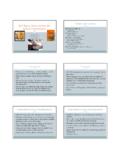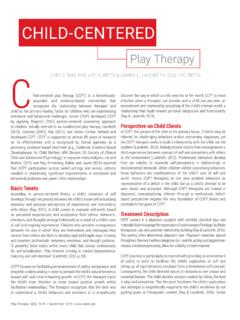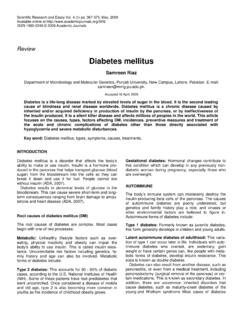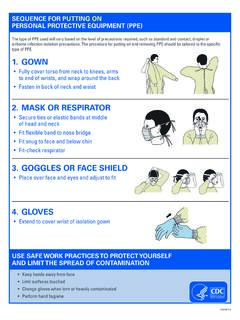Transcription of Overview of the Patient Driven Groupings Model
1 ### Related CR #### Page 1 of 10 Overview of the Patient Driven Groupings Model MLN Matters Number: SE19027 Article release Date: November 25, 2019 Related CR Transmittal Number: N/A Related Change Request (CR) Number: N/A Effective Date: January 1, 2020 Implementation Date: January 1, 2020 PROVIDER TYPES AFFECTED This special edition MLN Matters article is intended for physicians that order home health services. PROVIDER ACTION NEEDED This article provides information on the implementation of the new Home Health Prospective Payment System (HH PPS) case-mix adjustment methodology named the Patient - Driven Groupings Model (PDGM). The PDGM will be implemented for home health periods of care starting on and after January 1, 2020.
2 BACKGROUND Medicare home health services are available to eligible Medicare beneficiaries. To be eligible for Medicare home health services, a physician must certify that a Patient : 1. Is confined to the home; 2. Needs skilled services (intermittent skilled nursing, physical therapy , speech-language pathology services, or a continuing need for occupational therapy after the need for skilled nursing, physical therapy and/or speech language pathology services have ceased); 3. Is under the care of a physician; 4. Receives services under a plan of care established and reviewed by a physician; and 5. Had a face-to-face encounter with a physician or allowed non-physician practitioner. Section 1814(a) and Section 1835(a) of the Act specify that an individual is considered confined to the home (homebound) if the following two criteria are met: MLN Matters SE19027 Related CR N/A Page 2 of 10 First Criteria One of the following must be met: Second Criteria Both of the following must be met: 1.
3 Because of illness or injury, the individual needs the aid of supportive devices such as crutches, canes, wheelchairs, and walkers; the use of special transportation; or the assistance of another person to leave their place of residence. 1. There must exist a normal inability to leave home. 2. Have a condition such that leaving his or her home is medically contraindicated. 2. Leaving home must require a considerable and taxing effort. The aged person who does not often travel from home because of frailty and insecurity brought on by advanced age would not be considered confined to the home for purposes of receiving home health services unless they meet the above conditions. The Patient may be considered homebound (that is, confined to the home) if absences from the home are: Infrequent; For periods of relatively short duration; For the need to receive health care treatment; For religious services; To attend adult daycare programs; or For other unique or infrequent events (for example, funeral, graduation, trip to the barber).
4 Medicare covered home health services include: Skilled nursing (SN) care (other than solely venipuncture for the purposes of obtaining a blood sample) on part-time or intermittent basis; Home health aides on a part-time or intermittent basis; Physical therapy (PT); Occupational therapy (OT); Speech-language pathology (SLP); Medical social services; Routine & non-routine medical supplies (for example, catheters, catheter care supplies, ostomy bags, and ostomy care supplies); Durable Medical Equipment (paid separately from the home health prospective payment); Injectable osteoporosis drugs (reimbursed on a reasonable cost basis and the Patient must meet certain criteria); and Negative pressure wound therapy using disposable devices.
5 MLN Matters SE19027 Related CR N/A Page 3 of 10 Changes to Home Health Payment Since October 2000, Home Health Agencies (HHAs) have been paid under a Home Health Prospective Payment System (HH PPS) for 60-day episodes of care that include all covered home health services. The 60-day payment amount is adjusted for case-mix and area wage differences. The case-mix adjustment under this system included: a clinical dimension; a functional dimension; and a service dimension, in which payment would increase if certain thresholds of therapy visits were met. The Bipartisan Budget Act of 2018 (BBA of 2018) includes several requirements for home health payment reform, effective January 1, 2020.
6 These requirements include the elimination of the use of therapy thresholds for case-mix adjustment and a change from a 60-day unit of payment to a 30-day unit of payment. The mandated home health payment reform resulted in the Patient - Driven Groupings Model , or PDGM. The PDGM removes the current incentive to overprovide therapy , and instead, is designed to focus more heavily on clinical characteristics and other Patient information to better align Medicare payments with patients care needs. The Importance of Diagnosis Reporting and Physician Documentation under the PDGM Under the Medicare home health benefit, the Patient must be under the care of a physician and must be receiving home health services under a plan of care established and periodically reviewed by a physician.
7 Physicians play an important role in the provision of home health services and HHAs rely on documentation from the certifying physician (and/or the acute/post-acute care facility) to confirm home health eligibility, substantiate diagnoses that are populated on the home health claim and factor into the payment amount, and to help demonstrate the medical necessity of the home health services provided. The principal diagnosis code on the home health claim will assign the home health period of care to a clinical group that explains the primary reason the Patient is receiving home health services. For example, if the reported principal diagnosis is a stage 2 pressure ulcer of the left heel , the home health period of care would be assigned to the wound clinical group, meaning the primary reason for home health services is for wound care.
8 Payment varies between each of the clinical groups to account for the differences in resource use associated with the primary reason for home health care. There are certain diagnoses that are vague, unspecified, or not allowed to be reported as a principal diagnosis by ICD-10 coding guidelines that will not be assigned into a clinical group. If a home health claim is submitted with a principal diagnosis that would not be assigned to a clinical group under the PDGM, the claim would be returned to the HHA for more definitive diagnosis coding. The top 5 diagnoses reported on home health claims that would not be assigned to a clinical group are: , Muscle weakness, generalized Other abnormalities of gait and mobility , Low back pain , Unsteadiness on feet , Weakness MLN Matters SE19027 Related CR N/A Page 4 of 10 For example, if a Patient has been referred to home health with a principal diagnosis of muscle weakness, generalized ( ), this would not be assigned to a clinical group because this is a vague code that does not clearly support a rationale for skilled services.
9 If the underlying etiology of the generalized muscle weakness is unknown by the time a home health referral is made, a more definitive principal diagnosis is warranted in order to justify the need for skilled services and appropriate treatment. Further, if the original condition is resolved, but the resulting muscle weakness persists as a result of the known original diagnosis, we anticipate that a more specific code exists that accounts for why the muscle weakness is on-going, such as muscle wasting or atrophy. So, if , muscle wasting and atrophy of the right lower leg is reported as the principal diagnosis, the home health period of care would be assigned to the Musculoskeletal Rehab clinical group, meaning the primary reason for home health services is for therapy .
10 Additionally, if reported as a principal diagnosis, most symptom diagnoses will not be assigned to a clinical group under the PDGM. Clinically, it is important for HHAs to have a clear understanding of the patients diagnoses in order to safely and effectively furnish home health services. Interventions and treatment aimed at mitigating signs and symptoms of a condition may vary depending on the cause. For example, if a Patient has been referred to home health with a diagnosis of other abnormalities of gait and mobility ( ), it is important for the home health clinician to know what is precipitating the abnormality. For instance, a plan of care for a gait abnormality related to a neurological diagnosis (such as Parkinson s disease, G20) is likely to be different from a plan of care for a gait abnormality due to a fracture or injury (such as a fracture of the head and neck of femur, ).
















